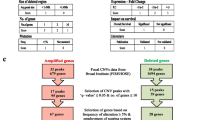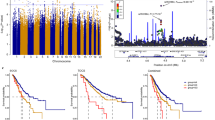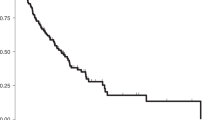Abstract
Frequent loss of heterozygosity (LOH) has been reported on 22q in ovarian carcinoma, implying the presence of a tumour-suppressor gene. The neurofibromatosis type 2 gene (NF2) at 22q12 is a plausible candidate. Analysis of 9 of the 17 exons of NF2 by single-strand conformational polymorphism (SSCP) in 67 ovarian carcinomas did not detect any somatic mutations, suggesting that NF2 is not involved in the pathogenesis of ovarian carcinoma. LOH data support this conclusion and that the putative tumour-suppressor gene lies distal to NF2, beyond D22S283.
This is a preview of subscription content, access via your institution
Access options
Subscribe to this journal
Receive 24 print issues and online access
$259.00 per year
only $10.79 per issue
Buy this article
- Purchase on SpringerLink
- Instant access to full article PDF
Prices may be subject to local taxes which are calculated during checkout
Similar content being viewed by others
Author information
Authors and Affiliations
Rights and permissions
About this article
Cite this article
Englefield, P., Foulkes, W. & Campbell, I. Loss of heterozygosity on chromosome 22 in ovarian carcinoma is distal to and is not accompanied by mutations in NF2 at 22q12. Br J Cancer 70, 905–907 (1994). https://doi.org/10.1038/bjc.1994.418
Issue date:
DOI: https://doi.org/10.1038/bjc.1994.418
This article is cited by
-
p300/CBP and cancer
Oncogene (2004)
-
High resolution chromosome 3p, 8p, 9q and 22q allelotyping analysis in the pathogenesis of gallbladder carcinoma
British Journal of Cancer (2002)
-
Quantitative real-time PCR identifies a critical region of deletion on 22q13 related to prognosis in oral cancer
Oncogene (2002)
-
Functional evidence for an ovarian cancer tumor suppressor gene on chromosome 22 by microcell-mediated chromosome transfer
Oncogene (2000)



